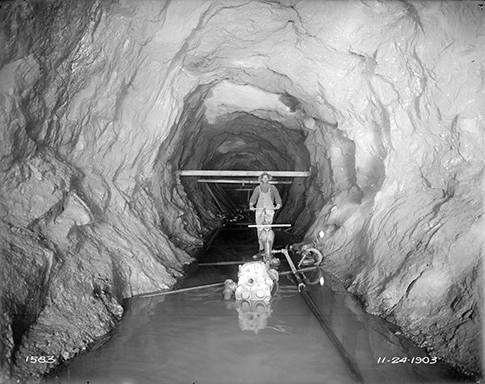
In this week’s throwback post, we look at a photo from the Philadelphia Water archives taken on October 24, 1903.
While a bit eerie—14 people died during the multiyear construction of the project pictured—this photo does give you a real sense of appreciation for the scale of water infrastructure beneath our feet and the herculean effort and sacrifice made by the generations before us to make sure their kids (and all of us) could have a future with clean, safe drinking water.
In this image, streams of groundwater entered the Torresdale Conduit as it was blasted out of bedrock, hampering construction. This worker used a hand-operated pump to remove the excess water. The conduit took two and a half years to complete, and had a capacity of 300 million gallons per day.
Still in use today, the Torresdale Conduit was built along the Delaware River waterfront in the first decade of the 20th century. It carries filtered water from the Torresdale Filters (now the Baxter Water Treatment Plant) to the Lardner’s Point Pumping Station, which pumps the water into the city’s system of distribution pipes. When they were completed, both the filter plant (covering about 75 acres) and the pumping station (with a capacity of 200 million gallons a day) were each the largest of their kind in the world.
In his 1987 book Typhoid and the Politics of Public Health in Nineteenth-century Philadelphia, Michael P. McCarthy wrote that the project was popular because the engineers saved about $2 million by using brick instead of cast iron. But there was also, apparently, some civic pride: “… the conduit was quite popular because, in addition to the savings involved, it was a sophisticated project that gave the city a good deal of favorable publicity.”
The conduit is about 2.5 miles long and about 10.5 feet in diameter. Constructed of bricks and mortar, it lies about 100 feet underground and is still an integral part of our water distribution system.
For more information on the history of the city’s water filtration system, check out the work of historian Adam Levine by clicking here.
